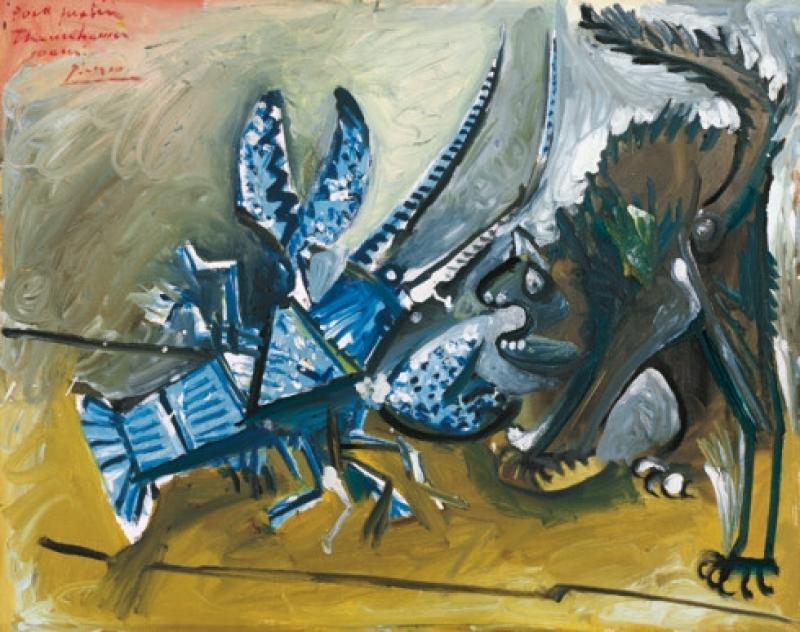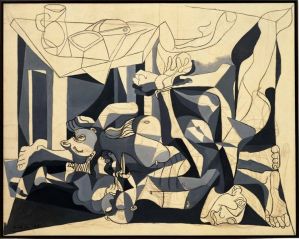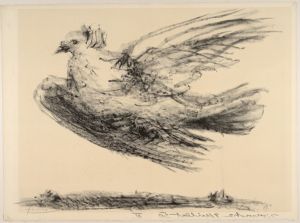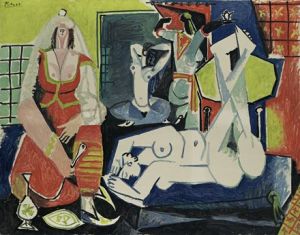Picasso Special - Picasso: Peace and Freedom, Tate Liverpool | reviews, news & interviews
Picasso Special - Picasso: Peace and Freedom, Tate Liverpool
Picasso Special - Picasso: Peace and Freedom, Tate Liverpool
Picasso the feminist? A sweeping survey puts the artist's politics under the spotlight

Picasso the genius, the sensualist, the womaniser, the priapic beast. This much we think we know of the great Spanish artist. But how about Picasso the political activist? Picasso the supporter of women’s causes? Picasso the… feminist? Oh, yes, that Picasso. In a landmark Liverpool exhibition focusing on the years 1944 to his death in 1973, and bringing together 150 works from around the globe, Picasso becomes all of these things.
In 1944, just like many of his generation of writers, intellectuals and artists, Picasso joined the Communist party. He was seeking, he said, an intellectual home, “until Spain can at last welcome me back”. With Spain under the rule of Franco, he was not only to remain a life-long member, but a life-long exile. During the occupation of Paris, when the Nazi occupiers sought to bribe the great and the good with offers of food and coal, he defiantly declared that “a Spaniard is never cold". And although his work was banned in the Soviet Union for not adhering to the strictures of socialist realism, Picasso’s declaration of allegiance to the cause was considered a mighty Soviet coup.
 There’s much that gives support to this previously unexplored side to the artist, not least the photos we see of Picasso tirelessly attending various international peace congresses across Europe. And, of course, there are his great anti-fascism paintings. We kick off with one of the most striking: The Charnel House,1945 (pictured right), depicting the massacre of a young family of Spanish Republicans in their kitchen. Limbs are trussed and twisted and bodies are tangled in a heap. Painted in the style of the powerful Guernica, 1937, which commemorated the destruction of the Basque capital by German and Italian bombers, the painting’s stark grey tones resemble newsprint.
There’s much that gives support to this previously unexplored side to the artist, not least the photos we see of Picasso tirelessly attending various international peace congresses across Europe. And, of course, there are his great anti-fascism paintings. We kick off with one of the most striking: The Charnel House,1945 (pictured right), depicting the massacre of a young family of Spanish Republicans in their kitchen. Limbs are trussed and twisted and bodies are tangled in a heap. Painted in the style of the powerful Guernica, 1937, which commemorated the destruction of the Basque capital by German and Italian bombers, the painting’s stark grey tones resemble newsprint.
Elsewhere, we see the trussed and twisted feet of a cockerel, strung up under a bulb, like a torture victim. And death, death is everywhere: human skulls, goat skulls, a lumpen bronze skull, a picture of an owl that looks part simian and part death’s head. Picasso feared death, the extinction of his own light, but the smell of death perpetrated by murderous tyrannies must have haunted him, too. At that time, of course, the murderous regime of the Soviet system had not yet been fully exposed.
And we don’t just find evidence of political commitment in the paintings and sculptures and a few congress photo-calls. In addition, there are telegrams from Castro, a drawing for a poster for an anti-racism campaign, a photo of him staring at a poster of a cheery Joe Stalin. We learn, too, that he donated millions of francs to striking miners and supported, through donations of his work, various women’s causes. On the question of Algerian independence, he was quick to declare his colours: we see a drawing of a young Algerian woman, accused by the French of being a terrorist bomber. Smiling prettily, she wears her hair in a fashionable Sixties bouffant. He certainly gave that particular cause its poster girl.
 Picasso also designed the posters for the various peace congresses with versions of his iconic peace dove, a motif that takes centre stage in this exhibition and adorns the exhibition catalogue. There are doves decorating ceramic plates, free-standing terracotta doves, prints, drawings (pictured left: Flying Dove,1950) and paintings of doves – though it’s amusing that Picasso himself says he never understood why the dove should be appropriated as a symbol of peace, since he always considered it to be a cruel, aggressive bird.
Picasso also designed the posters for the various peace congresses with versions of his iconic peace dove, a motif that takes centre stage in this exhibition and adorns the exhibition catalogue. There are doves decorating ceramic plates, free-standing terracotta doves, prints, drawings (pictured left: Flying Dove,1950) and paintings of doves – though it’s amusing that Picasso himself says he never understood why the dove should be appropriated as a symbol of peace, since he always considered it to be a cruel, aggressive bird.
All this is well and good, but when it comes to interpreting individual works, Tate Liverpool’s thesis is only sometimes convincing, and occasionally absurdly tenuous. A humorous 1965 painting of a lobster and a cat (main picture) confronting one another in terror, is pushed as a metaphor for the Cuban Missile Crisis. Well, maybe it is and maybe it isn't, but the curatorial material takes a far too didactic line, on this and other works.
And although we see that Picasso was certainly sympathetic to the Algerian cause, his four variations of Delacroix’s Women of Algiers, (pictured below right: The Women of Algiers - Version J, 1955) are shown only in the light of a response to the1954 Algerian uprising. It seems more likely that he was responding to the very recent death of Matisse, the only living artist with whom he could converse. Picasso started the series in November 1954, the month Matisse died. Was it not more likely that Picasso was moved to start the series as a homage to his great friend? A sensual celebration of his colours and the decadent glory of his oriental women? As Picasso himself joked, “Matisse left me his odalisques”.
 The exhibition also insists that Picasso’s variations on Velázquez’s Las Meninas must be seen as anti-Franco satire. Given the cartoonish natures of the paintings, this, in fact, seems plausible. However, the idea that his series after Manet’s Déjeuner sur l’herbe is some kind of celebration of women’s lib – how? - is frankly pushing it. And what of his late, rather disturbing self-portraits as a musketeer in the last room? Painted in the last few years of his life, they presage his own death rather than show a “fear of empires, rascism and war”. They also, of course, show his love of Rembrandt.
The exhibition also insists that Picasso’s variations on Velázquez’s Las Meninas must be seen as anti-Franco satire. Given the cartoonish natures of the paintings, this, in fact, seems plausible. However, the idea that his series after Manet’s Déjeuner sur l’herbe is some kind of celebration of women’s lib – how? - is frankly pushing it. And what of his late, rather disturbing self-portraits as a musketeer in the last room? Painted in the last few years of his life, they presage his own death rather than show a “fear of empires, rascism and war”. They also, of course, show his love of Rembrandt.
Great artists are like magpies, and certainly Picasso was a magpie. And this complex and restless artist took inspiration where he could find it. Certainly layers can be peeled away to reveal an artist who absorbed everything and discarded almost nothing, including news of the horrifying events that were unfolding all around him, both in his native Spain and elsewhere.
And Picasso was passionate - about women, about life, about political causes. But it is his art that remained the greatest of all of his causes. This is an absorbing exhibition and we do get a side of Picasso that is not often explored (and much of the research is fascinating). But that doesn’t mean that we are entitled to completely overplay it.
- Picasso: Peace and Freedom at Tate Liverpool until 30 August
- Read theartsdesk Q&A with John Richardson, Picasso's biographer
- See theartsdesk gallery for a portfolio of Picasso's own favourite works
Share this article
Add comment
The future of Arts Journalism
You can stop theartsdesk.com closing!
We urgently need financing to survive. Our fundraising drive has thus far raised £49,000 but we need to reach £100,000 or we will be forced to close. Please contribute here: https://gofund.me/c3f6033d
And if you can forward this information to anyone who might assist, we’d be grateful.

Subscribe to theartsdesk.com
Thank you for continuing to read our work on theartsdesk.com. For unlimited access to every article in its entirety, including our archive of more than 15,000 pieces, we're asking for £5 per month or £40 per year. We feel it's a very good deal, and hope you do too.
To take a subscription now simply click here.
And if you're looking for that extra gift for a friend or family member, why not treat them to a theartsdesk.com gift subscription?
more Visual arts
 'We are bowled over!' Thank you for your messages of love and support
Much-appreciated words of commendation from readers and the cultural community
'We are bowled over!' Thank you for your messages of love and support
Much-appreciated words of commendation from readers and the cultural community
 Folkestone Triennial 2025 - landscape, seascape, art lovers' escape
Locally rooted festival brings home many but not all global concerns
Folkestone Triennial 2025 - landscape, seascape, art lovers' escape
Locally rooted festival brings home many but not all global concerns
 Sir Brian Clarke (1953-2025) - a personal tribute
Remembering an artist with a gift for the transcendent
Sir Brian Clarke (1953-2025) - a personal tribute
Remembering an artist with a gift for the transcendent
 Emily Kam Kngwarray, Tate Modern review - glimpses of another world
Pictures that are an affirmation of belonging
Emily Kam Kngwarray, Tate Modern review - glimpses of another world
Pictures that are an affirmation of belonging
 Kiefer / Van Gogh, Royal Academy review - a pairing of opposites
Small scale intensity meets large scale melodrama
Kiefer / Van Gogh, Royal Academy review - a pairing of opposites
Small scale intensity meets large scale melodrama
 Jenny Saville: The Anatomy of Painting, National Portrait Gallery review - a protégé losing her way
A brilliant painter in search of a worthwhile subject
Jenny Saville: The Anatomy of Painting, National Portrait Gallery review - a protégé losing her way
A brilliant painter in search of a worthwhile subject
 Abstract Erotic, Courtauld Gallery review - sculpture that is sensuous, funny and subversive
Testing the boundaries of good taste, and winning
Abstract Erotic, Courtauld Gallery review - sculpture that is sensuous, funny and subversive
Testing the boundaries of good taste, and winning
 Edward Burra, Tate Britain review - watercolour made mainstream
Social satire with a nasty bite
Edward Burra, Tate Britain review - watercolour made mainstream
Social satire with a nasty bite
 Ithell Colquhoun, Tate Britain review - revelations of a weird and wonderful world
Emanations from the unconscious
Ithell Colquhoun, Tate Britain review - revelations of a weird and wonderful world
Emanations from the unconscious
 Rachel Jones: Gated Canyons, Dulwich Picture Gallery review - teeth with a real bite
Mouths have never looked so good
Rachel Jones: Gated Canyons, Dulwich Picture Gallery review - teeth with a real bite
Mouths have never looked so good
 Yoshitomo Nara, Hayward Gallery review - sickeningly cute kids
How to make millions out of kitsch
Yoshitomo Nara, Hayward Gallery review - sickeningly cute kids
How to make millions out of kitsch
 Hamad Butt: Apprehensions, Whitechapel Gallery review - cool, calm and potentially lethal
The YBA who didn’t have time to become a household name
Hamad Butt: Apprehensions, Whitechapel Gallery review - cool, calm and potentially lethal
The YBA who didn’t have time to become a household name

Comments
...